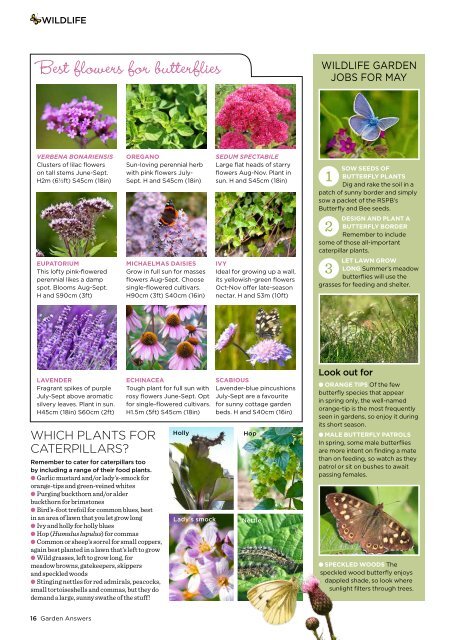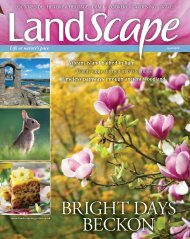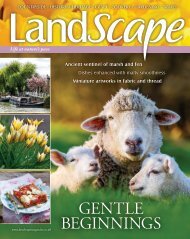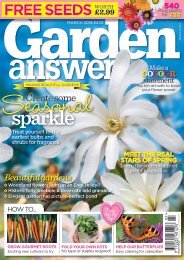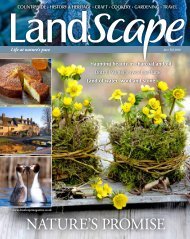Garden Answers Mini-Mag
Get a taste of the lovely Garden Answers magazine with this free sampler!
Get a taste of the lovely Garden Answers magazine with this free sampler!
Create successful ePaper yourself
Turn your PDF publications into a flip-book with our unique Google optimized e-Paper software.
WILDLIFE<br />
Best flowers for butterflies<br />
WILDLIFE GARDEN<br />
JOBS FOR MAY<br />
VERBENA BONARIENSIS<br />
Clusters of lilac flowers<br />
on tall stems June-Sept.<br />
H2m (6½ft) S45cm (18in)<br />
OREGANO<br />
Sun-loving perennial herb<br />
with pink flowers July-<br />
Sept. H and S45cm (18in)<br />
SEDUM SPECTABILE<br />
Large flat heads of starry<br />
flowers Aug-Nov. Plant in<br />
sun. H and S45cm (18in)<br />
1<br />
SOW SEEDS OF<br />
BUTTERFLY PLANTS<br />
Dig and rake the soil in a<br />
patch of sunny border and simply<br />
sow a packet of the RSPB’s<br />
Butterfly and Bee seeds.<br />
2<br />
DESIGN AND PLANT A<br />
BUTTERFLY BORDER<br />
Remember to include<br />
some of those all-important<br />
caterpillar plants.<br />
EUPATORIUM<br />
This lofty pink-flowered<br />
perennial likes a damp<br />
spot. Blooms Aug-Sept.<br />
H and S90cm (3ft)<br />
MICHAELMAS DAISIES<br />
Grow in full sun for masses<br />
flowers Aug-Sept. Choose<br />
single-flowered cultivars.<br />
H90cm (3ft) S40cm (16in)<br />
IVY<br />
Ideal for growing up a wall,<br />
its yellowish-green flowers<br />
Oct-Nov offer late-season<br />
nectar. H and S3m (10ft)<br />
3<br />
LET LAWN GROW<br />
LONG Summer’s meadow<br />
butterflies will use the<br />
grasses for feeding and shelter.<br />
LAVENDER<br />
Fragrant spikes of purple<br />
July-Sept above aromatic<br />
silvery leaves. Plant in sun.<br />
H45cm (18in) S60cm (2ft)<br />
WHICH PLANTS FOR<br />
CATERPILLARS?<br />
Remember to cater for caterpillars too<br />
by including a range of their food plants.<br />
l Garlic mustard and/or lady’s-smock for<br />
orange-tips and green-veined whites<br />
l Purging buckthorn and/or alder<br />
buckthorn for brimstones<br />
l Bird’s-foot trefoil for common blues, best<br />
in an area of lawn that you let grow long<br />
l Ivy and holly for holly blues<br />
l Hop (Humulus lupulus) for commas<br />
l Common or sheep’s sorrel for small coppers,<br />
again best planted in a lawn that’s left to grow<br />
l Wild grasses, left to grow long, for<br />
meadow browns, gatekeepers, skippers<br />
and speckled woods<br />
l Stinging nettles for red admirals, peacocks,<br />
small tortoiseshells and commas, but they do<br />
demand a large, sunny swathe of the stuff!<br />
ECHINACEA<br />
Tough plant for full sun with<br />
rosy flowers June-Sept. Opt<br />
for single-flowered cultivars.<br />
H1.5m (5ft) S45cm (18in)<br />
Holly<br />
Lady’s smock<br />
SCABIOUS<br />
Lavender-blue pincushions<br />
July-Sept are a favourite<br />
for sunny cottage garden<br />
beds. H and S40cm (16in)<br />
Hop<br />
Nettle<br />
Look out for<br />
l ORANGE TIPS Of the few<br />
butterfly species that appear<br />
in spring only, the well-named<br />
orange-tip is the most frequently<br />
seen in gardens, so enjoy it during<br />
its short season.<br />
l MALE BUTTERFLY PATROLS<br />
In spring, some male butterflies<br />
are more intent on finding a mate<br />
than on feeding, so watch as they<br />
patrol or sit on bushes to await<br />
passing females.<br />
l SPECKLED WOODS The<br />
speckled wood butterfly enjoys<br />
dappled shade, so look where<br />
sunlight filters through trees.<br />
16 <strong>Garden</strong> <strong>Answers</strong>


